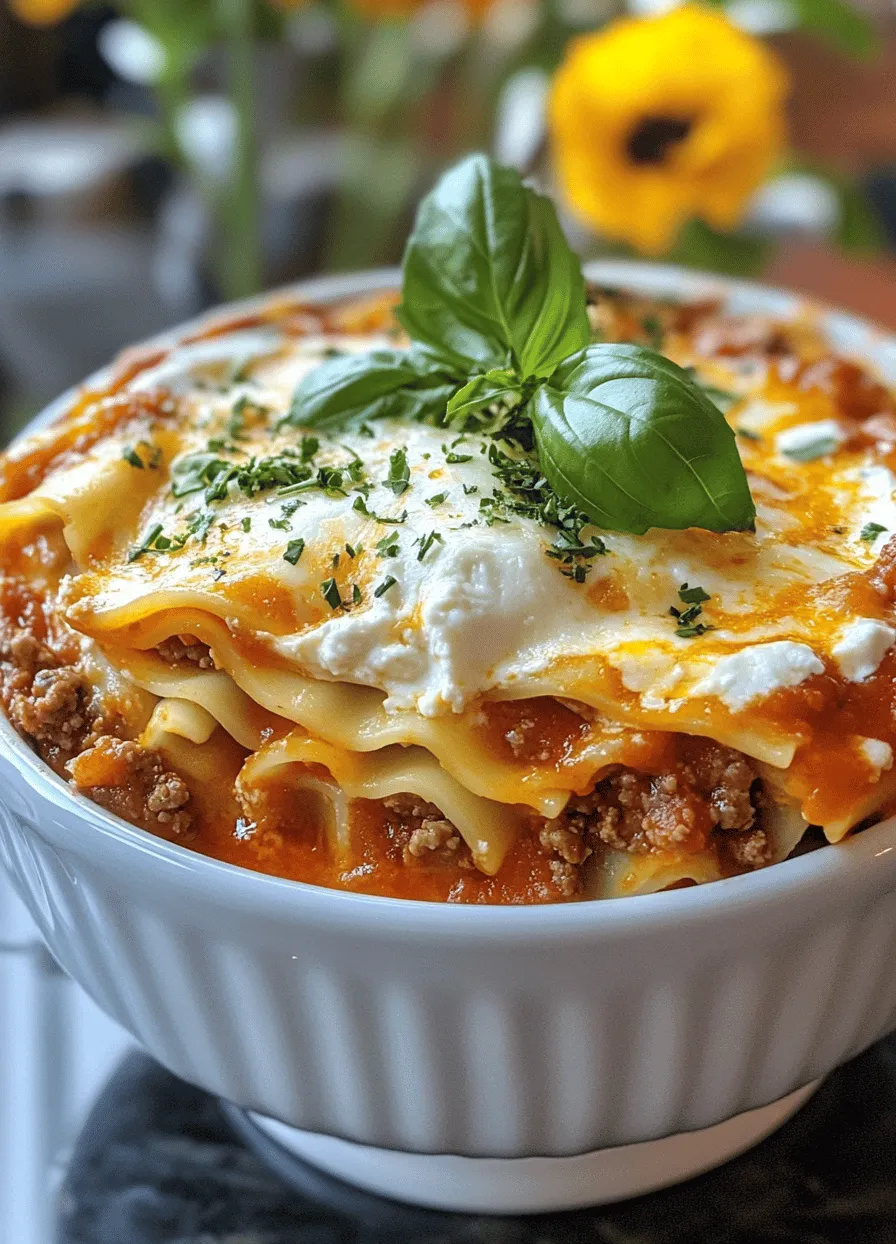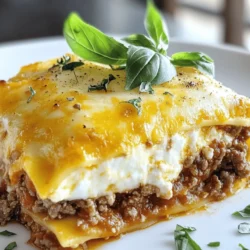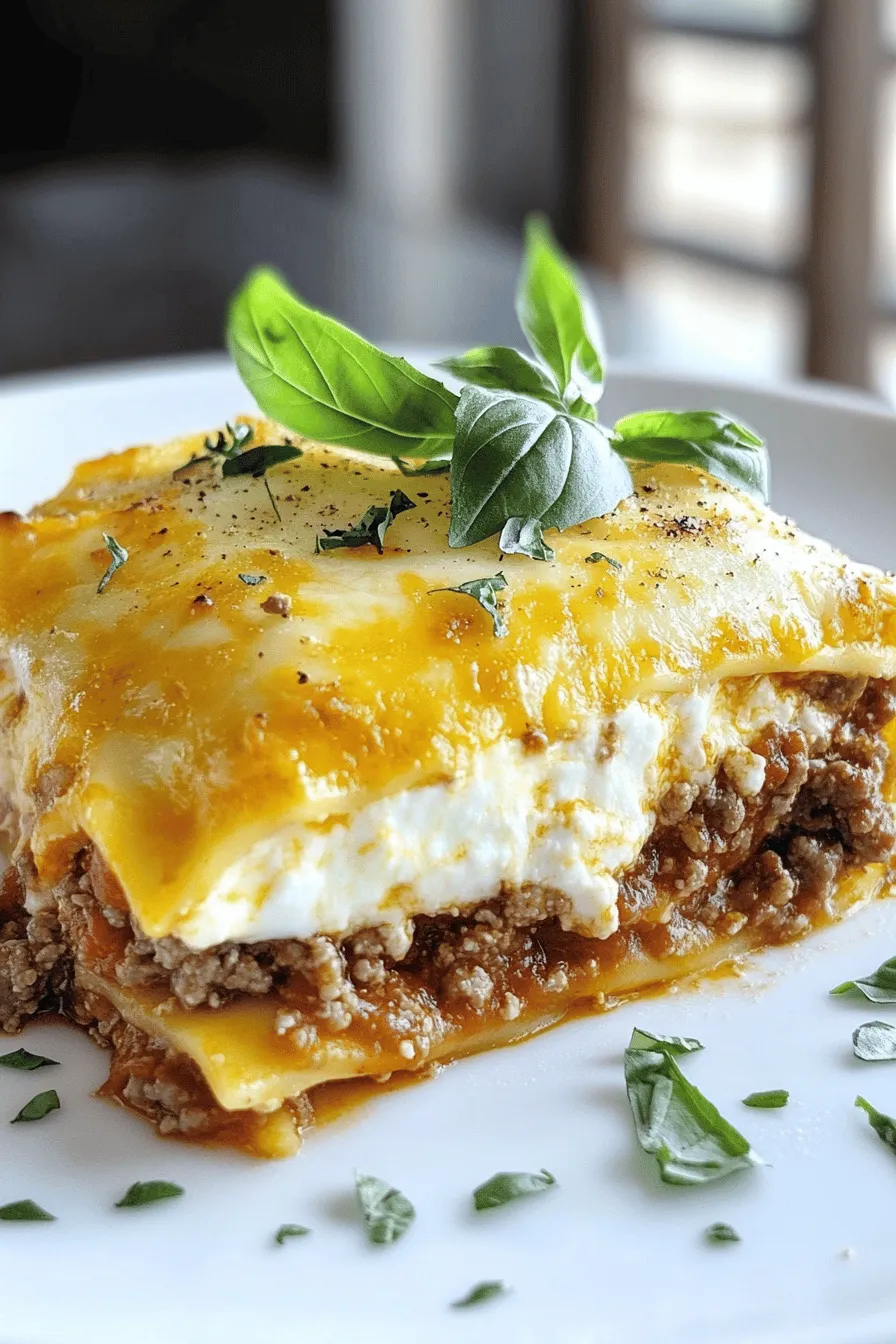Lasagna is more than just a meal; it is a symbol of comfort, family gatherings, and culinary tradition. This iconic Italian dish combines layers of pasta, savory meat, rich cheese, and a luscious sauce to create a heartwarming experience that has delighted palates for centuries. Today, we are excited to share “The Easiest Lasagna Ever,” a recipe that simplifies the traditional process without sacrificing the rich flavors and textures that make lasagna so beloved. Whether you are a novice in the kitchen or an experienced cook looking for a quick and satisfying dish, this recipe will guide you through each step with ease.
With a cooking time of just under an hour, this lasagna is perfect for busy weeknights when you want to serve your family a hearty meal without spending hours in the kitchen. It’s also an excellent choice for special occasions when you want to impress guests without the stress of complicated cooking techniques. As you prepare this easy lasagna, not only will you fill your kitchen with the enticing aromas of Italian spices, but you will also create an inviting atmosphere that brings everyone together at the dining table.
Understanding the Ingredients
Before diving into the cooking process, it’s essential to understand the key ingredients that make this lasagna a standout. Each component plays a significant role in creating the layers of flavor and texture that define this dish.
Essential Components of Lasagna
Lasagna Noodles
The foundation of any good lasagna is, of course, the noodles. Traditional lasagna noodles are flat sheets made from durum wheat flour and egg. They provide structure and absorb the flavors of the sauce and cheese. While you can use either regular or no-boil lasagna noodles, we recommend using regular noodles for the best texture. They should be boiled until al dente, which allows them to hold their shape during baking and prevent the lasagna from becoming too mushy.
Ground Beef or Italian Sausage
Choosing quality ground meat is crucial for a flavorful lasagna. Ground beef is a classic choice, but Italian sausage adds a delightful spice and depth of flavor that elevates the dish. When selecting your meat, look for grass-fed beef or high-quality sausage from a trusted butcher. This attention to quality will significantly enhance the taste of your lasagna.
Marinara Sauce
The sauce you choose can make or break your lasagna. Store-bought marinara sauce can be a convenient option, but homemade sauce allows you to control the flavors and ingredients. If you opt for store-bought, select a high-quality brand that uses fresh tomatoes and traditional Italian herbs. The sauce should have a balance of acidity and sweetness to complement the richness of the meat and cheese.
Cheese Selection and Its Significance
Ricotta Cheese
Ricotta cheese is a staple in lasagna and provides a creamy texture that contrasts beautifully with the other layers. Its mild flavor is enhanced when mixed with eggs and seasonings, creating a luscious filling that binds the layers together. When purchasing ricotta, look for fresh, whole-milk varieties for the best taste and texture.
Mozzarella Cheese
No lasagna is complete without gooey, melted mozzarella on top. This cheese not only adds a deliciously stretchy topping but also contributes to the overall richness of the dish. For optimal meltability, consider using whole-milk mozzarella cheese. You can also mix in some shredded mozzarella with the ricotta layer for extra cheesiness.
Parmesan Cheese
The finishing touch for your lasagna comes from freshly grated Parmesan cheese. This hard cheese adds a salty, nutty flavor that enhances the overall taste of the dish. Sprinkle it generously between layers and on top before baking for a delicious golden crust.
Seasoning and Flavor Profile
Italian Seasoning
Italian seasoning is a blend of dried herbs that typically includes basil, oregano, thyme, and rosemary. This seasoning is essential for adding depth and complexity to your lasagna. A generous sprinkle throughout the layers will infuse the dish with that unmistakable Italian flavor.
Salt and Pepper
Seasoning your meat and sauce with salt and pepper is crucial for balancing flavors. Don’t shy away from seasoning; a well-seasoned lasagna will elevate the dish and bring all the components together harmoniously.
Optional Garnishes
For an extra touch of freshness and flavor, consider garnishing your lasagna with fresh basil before serving. Not only does it add a pop of color, but it also enhances the dish’s aroma and provides a delightful herbaceous note.
Step-by-Step Cooking Process
Once you have gathered all your ingredients, it’s time to start cooking! Follow these detailed steps to prepare “The Easiest Lasagna Ever.”
Prepping the Ingredients
1. Prepare the Lasagna Noodles
Begin by boiling a large pot of salted water. Once the water reaches a rolling boil, carefully add the lasagna noodles. Cook them according to the package instructions until they are al dente, usually around 8-10 minutes. After cooking, drain the noodles and rinse them under cold water to stop the cooking process. Lay them flat on a clean kitchen towel or parchment paper to prevent sticking.
2. Brown the Meat
In a large skillet over medium heat, add your choice of ground beef or Italian sausage. Break the meat apart with a wooden spoon, allowing it to brown evenly. Cook until the meat is no longer pink, about 5-7 minutes. If using sausage, you may want to remove the casing first to crumble the meat more easily.
3. Drain Excess Fat
After browning the meat, drain any excess fat from the skillet. This step is crucial for preventing your lasagna from becoming greasy. You want to retain enough fat to keep the meat flavorful without overwhelming the dish.
4. Add Marinara Sauce
Once the meat is browned and drained, return it to the skillet. Pour in your marinara sauce, stirring to combine. Allow the mixture to simmer for about 5 minutes, letting the flavors meld together. If desired, add a pinch of Italian seasoning, salt, and pepper to taste.
Layering the Lasagna
Now that your ingredients are prepped, it’s time to assemble the lasagna. The layering technique is essential for achieving the perfect blend of flavors and textures.
1. Start with Sauce
Preheat your oven to 375°F (190°C). In a 9×13-inch baking dish, spread a thin layer of the meat sauce on the bottom. This prevents the noodles from sticking and adds flavor to the base.
2. Add Noodles
Place a layer of lasagna noodles over the sauce, ensuring they overlap slightly. This creates a solid foundation for the subsequent layers.
3. Spread Ricotta Mixture
In a bowl, mix the ricotta cheese with an egg, a pinch of salt, and a touch of Italian seasoning. Spread a generous layer of this mixture over the noodles, ensuring even coverage.
4. Sprinkle Mozzarella
Next, add a layer of shredded mozzarella cheese over the ricotta. This will melt beautifully during baking and create that signature cheesy topping.
5. Repeat the Layers
Continue layering the ingredients in the following order: meat sauce, noodles, ricotta mixture, mozzarella cheese. Repeat this process until you run out of ingredients, finishing with a layer of meat sauce on top.
6. Final Cheese Topping
Once you’ve completed the layers, sprinkle a generous amount of mozzarella and freshly grated Parmesan cheese over the final layer of meat sauce. This will create a deliciously golden and bubbly crust as it bakes.
Baking to Perfection
Now that your lasagna is assembled, it’s time to bake it to perfection.
1. Cover with Foil
To ensure even cooking and prevent the cheese from burning, cover the baking dish with aluminum foil. This helps to trap moisture, making sure the noodles cook through without drying out.
2. Bake
Place the covered lasagna in the preheated oven and bake for 25 minutes. After this initial baking time, carefully remove the foil and continue to bake for an additional 15-20 minutes, or until the cheese is melted and bubbly.
3. Check for Doneness
To determine if your lasagna is done, look for a golden, bubbly top and check that the edges are slightly browned. If the cheese is melted and the sauce is bubbling, your lasagna is ready to come out of the oven.
Creating “The Easiest Lasagna Ever” is a rewarding experience that fills your kitchen with delightful aromas and your dining table with warmth and laughter. As you prepare this dish, remember that the joy of cooking lies in the love and care you put into each layer. Enjoy the process, and get ready to serve up a comforting meal that will impress family and friends alike!

Tips for Storing and Reheating Lasagna
Storing Leftovers
After enjoying your delicious lasagna, you may find yourself with some leftovers. Proper storage is key to maintaining the flavor and texture of this beloved dish. Here are the best practices for refrigerating and freezing lasagna:
1. Refrigerating: If you plan to consume the lasagna within a few days, simply cover it tightly with plastic wrap or aluminum foil and place it in the refrigerator. Properly stored, it can last for up to 3-5 days. If you have a large portion, consider cutting it into individual servings to make reheating easier later on.
2. Freezing: For longer storage, lasagna freezes beautifully. Make sure it is completely cooled before freezing. Wrap the lasagna tightly in plastic wrap followed by aluminum foil to prevent freezer burn. Alternatively, you can use an airtight container. Frozen lasagna can maintain its quality for up to 3 months. For best results, label the container with the date so you can keep track of how long it has been stored.
To maintain flavor and texture during storage, avoid adding any toppings such as cheese or fresh herbs until you are ready to reheat and serve. This helps in preserving their freshness and prevents them from becoming soggy.
Reheating Techniques
When it’s time to enjoy your leftovers, reheating properly is essential to keeping your lasagna moist and flavorful. Here are several methods you can use:
1. Oven: This is the best method for reheating lasagna, as it helps retain moisture. Preheat your oven to 375°F (190°C). Place the lasagna in an oven-safe dish, cover it with aluminum foil to keep it from drying out, and heat for about 25-30 minutes, or until it is heated through. For a crispy top, remove the foil during the last 10 minutes of cooking.
2. Microwave: If you need a quicker option, the microwave works well too. Place a serving of lasagna on a microwave-safe plate and cover it with a damp paper towel to help keep it moist. Heat on medium power for 2-3 minutes, checking for doneness and stirring if necessary. Note that the microwave can sometimes lead to a slightly soggy texture, so use this method only if you’re short on time.
3. Skillet: For a unique reheating method, consider using a skillet. Heat a small amount of olive oil in a skillet over medium heat and add a slice of lasagna. Cover the skillet with a lid and heat for about 5-7 minutes, or until heated through. This method gives the bottom a nice crispy texture while keeping the rest moist.
Variations and Customization Ideas
Exploring Meat Alternatives
One of the best features of lasagna is its versatility. If you’re looking to create a vegetarian version, consider using mushrooms or lentils as a hearty meat substitute.
1. Mushrooms: Sauté sliced mushrooms with onions and garlic before layering them in your lasagna. Their earthy flavor adds depth, and they provide a satisfying texture.
2. Lentils: Cooked lentils are another excellent alternative. They are high in protein and fiber, making them a nutritious choice. Combine them with your marinara sauce for a filling layer.
You can also incorporate different types of protein, such as ground turkey or chicken, if you desire a lighter version of the traditional meat lasagna. For seafood lovers, adding shrimp or crab can provide a gourmet twist.
Sauce Variations
While marinara sauce is a classic choice, experimenting with different sauces can lead to exciting variations.
1. Alfredo Sauce: For a creamy and rich alternative, consider using Alfredo sauce instead of marinara. The combination of pasta, cheese, and Alfredo creates a luxurious dish that is sure to impress.
2. Pesto: For a fresh and vibrant flavor, try using pesto sauce. Layer it with ricotta and mozzarella for a unique take on lasagna that’s packed with basil goodness.
Additionally, if you’re feeling adventurous, why not try making your own sauce? A homemade marinara or a white sauce can elevate your lasagna and provide a distinct flavor profile.
Cheese Alternatives
Cheese is a key component of lasagna, but it can be adjusted to accommodate dietary restrictions.
1. Dairy-Free Cheese: If you are lactose intolerant or following a vegan diet, there are numerous dairy-free cheese options available. Look for brands that offer mozzarella-style cheese or create your own using cashews and nutritional yeast for a creamy layer.
2. Combining Cheeses: For those who enjoy a rich flavor, consider mixing different types of cheese. Combining ricotta, mozzarella, and Parmesan can create a complex flavor profile that enhances the overall dish.
Nutritional Information
Breakdown of Nutritional Content
Understanding the nutritional content of your lasagna can help you enjoy it guilt-free. A typical serving of lasagna (about 1 cup) contains approximately:
– Calories: 350-400 calories, depending on the ingredients used
– Protein: 20-25 grams, providing a good source of muscle-building nutrients
– Carbohydrates: 40-50 grams, primarily from the noodles and sauce
– Fats: 15-20 grams, which can vary based on the cheese and meat used
This breakdown indicates that lasagna can be a well-balanced meal, containing a mix of protein, carbohydrates, and fats.
Healthier Modifications
If you’re looking to make your lasagna a bit healthier, consider the following modifications:
1. Reduce Calories: Substitute regular pasta with whole grain or zucchini noodles to lower carbohydrate content while adding fiber.
2. Increase Vegetables: Incorporate a variety of vegetables such as spinach, zucchini, or bell peppers. Not only do they add nutrition, but they also enhance the flavor and texture of the dish.
3. Lean Proteins: Use lean ground meats or turkey to cut down on saturated fat. This simple swap can make a significant difference in the overall healthiness of your lasagna.
Conclusion
In conclusion, “The Easiest Lasagna Ever” exemplifies a dish that is not only delicious but also adaptable to various tastes and dietary needs. This straightforward recipe allows for creativity in the kitchen while providing a comforting meal that can be enjoyed by all. Whether serving it for a family dinner or a potluck, this lasagna will surely become a favorite in your home. Enjoy the process of making it as much as you enjoy eating it. With simple storage techniques, versatile variations, and nutritional modifications, this lasagna is not just a meal but a canvas for your culinary imagination. So gather your ingredients, follow the steps, and savor the delightful experience of crafting your very own lasagna masterpiece!


